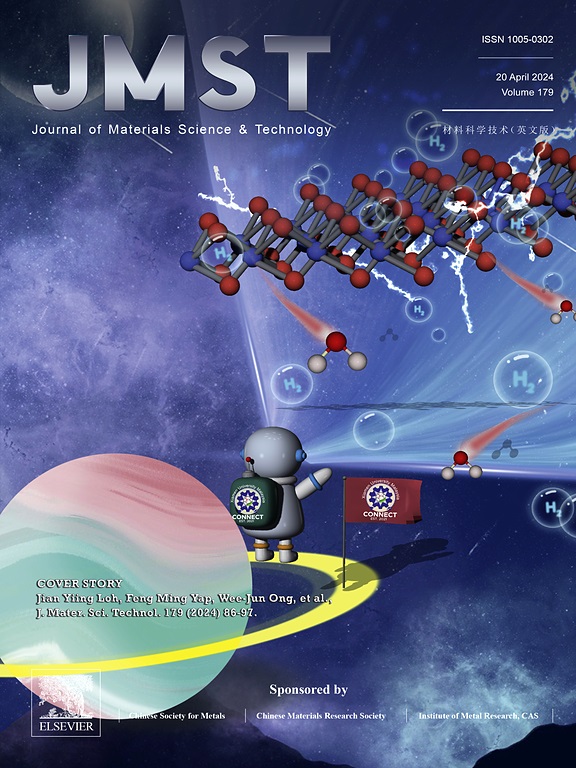激光粉末床熔合原位合金化高强度、低模量、延展性亚稳β Ti-Nb-Zr-Fe合金
IF 11.2
1区 材料科学
Q1 MATERIALS SCIENCE, MULTIDISCIPLINARY
引用次数: 0
摘要
采用激光粉末床熔合(LPBF)原位合金化制备了一种新型的高强度、低模量、延展性的亚稳β Ti-14Nb-6Zr-3Fe (TNZF)合金。工艺参数优化使样品接近完全致密(<;0.1%孔隙率)。然后采用棋盘扫描和简单扫描两种方法对TNZF合金的组织和力学性能进行了定制。与使用简单扫描策略制备的AS-TNZF相比,使用棋盘扫描策略制备的样品(CS-TNZF)受益于较低的热梯度,与添加Fe相关的高生长限制因子以及残余Nb颗粒周围的成分过冷,从而产生近等轴晶粒结构(平均长径比:2.0)。微观结构由β-Ti基体和2-5 nm大小的ω相组成。由于Zr的加入,与LPBF相关的热循环过程中从β到ω的转变被抑制,导致部分坍塌的ω相的存在。在不进行后处理热处理的情况下,AS-TNZF的屈服强度为1091 MPa,弹性模量为68 GPa,伸长率为16.8%,而CS-TNZF的屈服强度为1147 MPa,弹性模量为71 GPa,但由于ω相的体积分数较高,伸长率较低,为10.8%。AS-TNZF和CS-TNZF的弹性容许应变值(YS/E比)分别为1.60和1.62,具有高强度、低模量和良好的延展性,适合作为生物医用植入材料。本文章由计算机程序翻译,如有差异,请以英文原文为准。
High strength, low modulus, and ductile metastable beta Ti-Nb-Zr-Fe alloys by laser powder bed fusion in-situ alloying
A novel, high strength, low modulus, and ductile metastable β Ti-14Nb-6Zr-3Fe (TNZF) alloy was manufactured via laser powder bed fusion (LPBF) in-situ alloying. Process parameter optimization resulted in near-fully dense samples (< 0.1% porosity) under optimal conditions. The microstructure and mechanical properties of TNZF alloy were then tailored using two chessboard scanning strategies and a simple scanning strategy. Samples fabricated using the chessboard scanning strategy (CS-TNZF) benefited from a lower thermal gradient, the high growth restriction factor associated with the addition of Fe, and constitutional supercooling around residual Nb particles, resulting in a near-equiaxed grain structure (average aspect ratio: 2.0) compared to the AS-TNZF (fabricated using the simple scanning strategy). The microstructure consisted of a β-Ti matrix with 2–5 nm sized ω precipitates. Due to the addition of Zr, the transition from β to ω was suppressed during thermal cycling associated with LPBF, resulting in the presence of a partially collapsed ω phase. Without post-processing heat treatments, the AS-TNZF condition exhibited a yield strength (YS) of 1091 MPa, an elastic modulus (E) of 68 GPa, and an elongation (EL) of 16.8%, while the CS-TNZF counterpart achieved a higher YS of 1147 MPa and E of 71 GPa, but a lower EL of 10.8% due to a higher volume fraction of ω phase. Both AS-TNZF and CS-TNZF demonstrated high elastic admissible strain values (YS/E ratio) of 1.60 and 1.62, respectively, achieving high strength, low modulus, and good ductility, which indicates their suitability for biomedical implant materials.
求助全文
通过发布文献求助,成功后即可免费获取论文全文。
去求助
来源期刊

Journal of Materials Science & Technology
工程技术-材料科学:综合
CiteScore
20.00
自引率
11.00%
发文量
995
审稿时长
13 days
期刊介绍:
Journal of Materials Science & Technology strives to promote global collaboration in the field of materials science and technology. It primarily publishes original research papers, invited review articles, letters, research notes, and summaries of scientific achievements. The journal covers a wide range of materials science and technology topics, including metallic materials, inorganic nonmetallic materials, and composite materials.
 求助内容:
求助内容: 应助结果提醒方式:
应助结果提醒方式:


